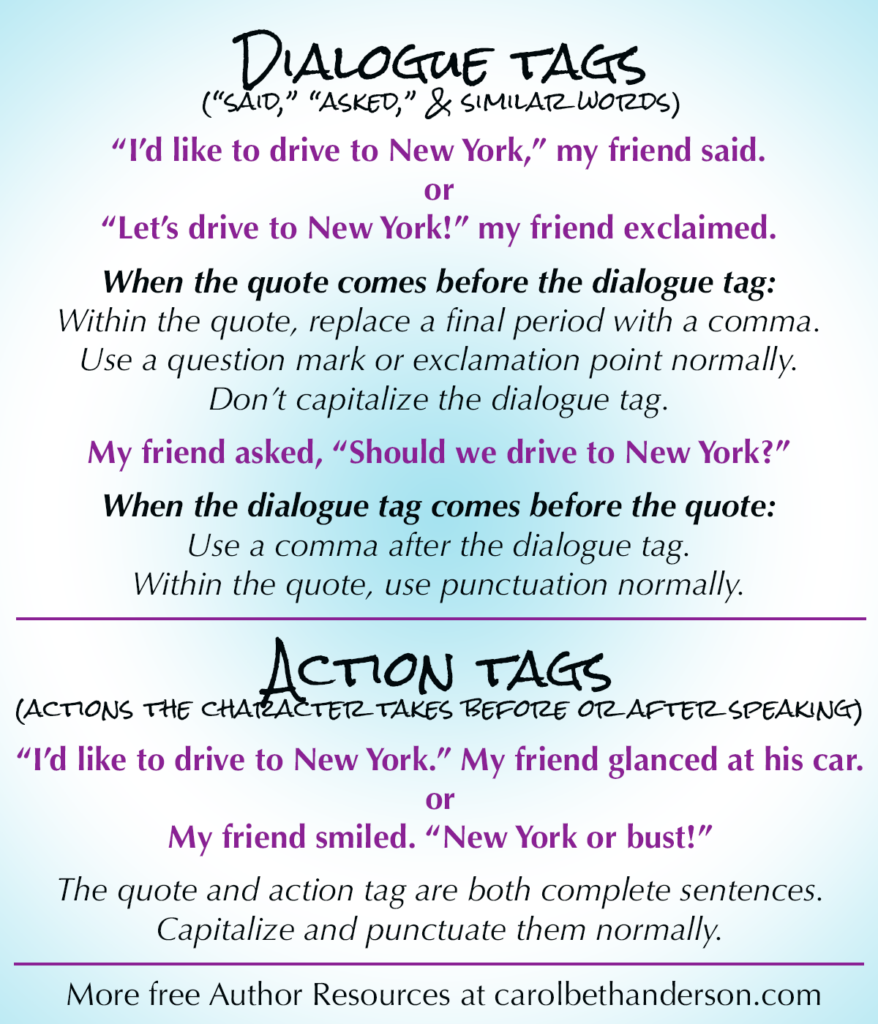I’ve done a fair amount of beta reading for other authors, and I’ve noticed several recurring errors many authors make.
Let me be clear:
It’s okay to struggle with grammar when you’re a writer.
Grammar and storytelling are different skills, and copy editors/proofreaders exist for a reason!
That being said, the better your grammar, the smoother your writing, publishing, and marketing processes will likely be.
In this blog series, I’ll review core grammar rules and how they’re often broken. Let’s get started with our first one, punctuation when using dialogue tags and action tags.
In the sections below, you’ll find the following:
- Examples and detailed rules
- Typical errors and how to fix them
- An “in-a-nutshell” downloadable image with examples and quick rules
Punctuation When Using Dialogue Tags and Action Tags
Dialogue Tags
What’s a dialogue tag?
- A dialogue tag is a short indication of who’s speaking. It identifies the character and includes a verb such as said, asked, whispered, or exclaimed.
- Dialogue tags include phrases like, “my friend said,” “Joe exclaimed,” and “Alma asked.”
- The verb used in a dialogue tag must be said or another word that can be used in place of said. You can say, ask, whisper, or even growl a statement. You can’t swallow or blink a statement. (See the Action Tags section below!)
How do I punctuate dialogue tags?
- Example 1: “I’d like to drive to New York,” my friend said.
- In this example, the dialogue tag is used after a quote that would normally end in a period.
- Use a comma in place of the period at the end of your quote (within the quotation marks).
- Don’t capitalize the beginning of your dialogue tag unless it’s a proper name.
- Example 2: “Let’s drive to New York!” my friend exclaimed.
- In this example, the dialogue tag is used after a quote that’s an exclamation. These rules apply to quotes that are questions too.
- Use a question mark or exclamation point at the end of your quote (within the quotation marks).
- Don’t capitalize the beginning of your dialogue tag unless it’s a proper name.
- Example 3: My friend asked, “Should we drive to New York?”
- In this example, the dialogue tag is used before the quote.
- Use a comma at the end of the dialogue tag.
- Use normal end-of-sentence punctuation at the end of the quote, within the quotation marks.
Action Tags
What’s an action tag?
- An action tag describes an action that a speaker takes before or after they speak. It identifies the character and is a complete sentence with a subject and predicate (verb).
- Why use action tags?
- They help us follow a classic rule: show, don’t tell. Instead of a character saying something “nervously,” we can write that the character “chewed on her lip.”
- Action tags allow us to identify characters without using said so often.
How do I punctuate action tags?
- Example 4: “I’d like to drive to New York.” My friend glanced at his car.
- Example 5: My friend smiled. “New York or bust!”
- In these examples, the action tags are “My friend glanced at his car.” and”My friend smiled.“
- Action tags are complete sentences, unlike dialogue tags!
- Punctuate the quote with normal punctuation within the quotation marks.
- Punctuate the action tag with normal, end-of sentence punctuation.
Typical Errors and How to Fix Them
Error 1
- Mistake: “I want some cookies.” She said.
- This is punctuated as an action tag, but it’s a dialogue tag. See Example 1 above.
- Correction: “I want some cookies,” she said.
Error 2
- Mistake: “I can’t believe you’d do that!” She screamed.
- Even though the dialogue ends with an exclamation point (or question mark), “she” shouldn’t be capitalized since “she screamed” is a dialogue tag. See Example 2 above.
- Correction: “I can’t believe you’d do that!” she screamed.
Error 3
- Mistake: “I’ve loved you since the moment I saw you,” she wrapped her arms around his waist.
- This is punctuated as a dialogue tag, but it’s an action tag. I see this mistake all the time!
- The action tag is a complete sentence and should be treated as such. See Example 4 above.
- Correction: “I’ve loved you since the moment I saw you.” She wrapped her arms around his waist.
Error 4
- Mistake: Sal smiled, “I didn’t know you liked cotton candy.”
- This is punctuated as a dialogue tag, but it’s an action tag. Again, this is an incredibly common error. You can say a sentence or scream a sentence; you can’t smile a sentence!
- “Sal smiled” is a complete sentence and should be treated as such. See Example 5 above.
- Correction: Sal smiled. “I didn’t know you liked cotton candy.”
Error 5
- Mistake: Running from the monster, “Somebody help me!”
- This is an action tag, but it’s punctuated like a dialogue tag, and it’s not a complete sentence.
- Action tags should always be complete sentences and should be punctuated as such. See Example 5 above.
- Correction: Walter ran from the monster. “Somebody help me!“
- Alternate Correction: This could be reworded (and punctuated) as a dialogue tag. Running from the monster, Walter gasped, “Somebody help me!”
Here’s an image you’re welcome to download to help you remember these rules! Right-click to save it to your computer, or hard-click to save to your phone.

“Now sit and write some amazing dialogue,” Beth said.
Want to be notified every time I post an Author Resource?
Author Resources on my website are 100% free. But if you’d like to buy me a coffee to thank me, click the “Tip Me” button below!
